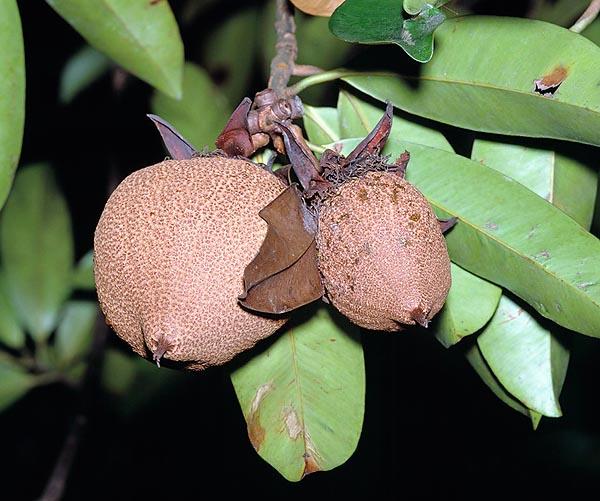Family : Clusiaceae

Text © Pietro Puccio

English translation by Mario Beltramini

The Pentadesma butyracea is a tropical tree with edible fruits, sweet when ripe © Giuseppe Mazza
The name of the genus is the combination of the Greek words “penta” = five and “desma” = bundle, with reference to the stamens grouped in five sheaf; the name of the species comes from the Latin “butyrum” = butter, with reference to the presence of oil in the seeds.
Common names: lack mango tree, butter tree, candle tree, candle butter tree, kanya, tallow tree (English); arbre à beurre, arbre à chandelle, lami (French); mamão, mata passo, pau ová (Portuguese); árbol del sebo (Spanish).
The Pentadesma butyracea Sabine (1824) is an evergreen or semi-deciduous tree, which partially loses the leaves during the dry season, up to about 30 m tall with a diameter reaching even the 1,3 m; the bark is brownish and finely fissured along its length.
The leaves, on an about 2,5 cm long petiole, are opposite and grouped at the apex of the branches, usually with an obovate shape, 10-20 c long and 3-7 cm broad, coriaceous, of a glossy intense green colour on the upper page, pale green below and dotted by resinous glandulae. It has panicle inflorescences carrying 1 to 7 flowers with 6 cm long, ovate, petals, of a colour varying from the reddish to the greenish white, and numerous stamens united in five bundles merged at the base; the flowers emit an odour which reminds that of the rancid butter.
The fruits are reddish brown ellipsoid berries with sharp apex, 10-15 cm long and with a diameter of 6 to 10 cm, containing a yellow flesh, edible and sweet in the ripe fruits, sour in the green ones, inside which are sunk 3 to 15 flattened seeds, 3-4 cm long and of brown colour.
It easily reproduces by seed which is to be planted as soon as possible because it quickly loses the germinating power; the substratum must be draining, rich of humus, and at a temperature of 22-26 °C. It germinates in about two weeks, at times, the germination begins in the fruit itself. Little cultivated species outside its areas of origin, it requires a humid tropical climate with an annual rainfall of more than 1000 mm.
The seeds contain from the 30 to the 40% of oil consisting for the 54% of oleic acid, 45% of stearic acid, 1,2% of palmitic acid and various amino acids; the oil may be extracted by pressing or cooking, it is solid at ambient temperature, almost tasteless, yellow and does not turn rancid; it is utilized for cooking and fabrication of margarine, soaps, candles, in the cosmetics, etc. The tree, thanks to its hard and resistant yellowish or pink wood, easily to work and little attackable by the insects, is variously employed in the constructions, in the vessels and for car parts; it is utilized locally also as fuel and in the reforestation. Decoctions of root and of bark are utilized in the traditional medicine.
Synonyms: Pentadesma parviflora Exell (1927).
→ To appreciate the biodiversity within the CLUSIACEAE family please click here.
